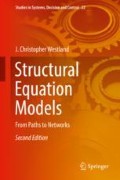Abstract
Partial least squares path methods elicit only pairwise relationships between latent constructs, though they allude to a more complete “plausible” structure. In the 1950s, the Cowles Commission at the University of Chicago and in the 1970s Karl Jöreskog of Uppsala University extended structural equation model methods to incorporate all of the information in the covariance structure, in what are called full-information methods. These methods placed structural equation models on secure statistical footing, allowing confirmatory testing of models of latent constructs. These models are substantially more complex than the crude methods used in PLS-PA, but provide performance measures that moved structural equation models from exploratory analysis into full-fledged hypothesis testing.
Access this chapter
Tax calculation will be finalised at checkout
Purchases are for personal use only
References
Bentler, Peter M. 1995. EQS Structural Equations ProgramManual. Vol. 6. Encino, CA: Multivariate Software.
Blau, P.M., O.D. Duncan, and A. Tyree. 1967. “The Process of Stratification.” In Social Stratification. Class, Race & Gender, 317–329. San Francisco: Boulder.
Blunch, N.J. 2008. Introduction to Structural Equation Modelling Using Spss and Amos. Thousand Oaks: Sage Publications Ltd.
Bollen, Kenneth A. 1989a. Structural Equations with Latent Variables. Vol. 8. New York: Wiley.
Browne, Michael W., and Robert Cudeck. 1989. “Single Sample Cross-Validation Indices for Covariance Structures.” Multivariate Behavioral Research 24 (4): 445–455.
———. 1992. “Alternative Ways of Assessing Model Fit.” Sociological Methods & Research 21 (2): 230–258.
———. 1993. “Alternative Ways of Assessing Model Fit.” Sage Focus Editions 154: 136.
Cheung, Gordon W., and Roger B. Rensvold. 2002. “Evaluating Goodness-of-Fit Indexes for Testing Measurement Invariance.” Structural Equation Modeling 9 (2): 233–255.
Cochran, William G., Frederick Mosteller, and John W. Tukey. 1954. “Principles of Sampling.” Journal of the American Statistical Association 49 (265): 13–35.
Dhrymes, Phoebus J., and H. Erlat. 1972. Asymptotic Properties of Full Information Estimators in Dynamic Autoregressive Simultaneous Models. Report. Los Angeles: UCLA Department of Economics.
Dhrymes, Phoebus J., E. Philip Howrey, Saul H. Hymans, Jan Kmenta, Edward E. Leamer, Richard E. Quandt, James B. Ramsey, Harold T. Shapiro, and Victor Zarnowitz. 1972. “Criteria for Evaluation of Econometric Models. Book Section.” In Annals of Economic and Social Measurement, Volume 1, Number 3, 291–325. Cambridge: NBER.
Fox, John. 2006. Teacher’s Corner: Structural Equation Modeling with the SEM Package in R. Structural Equation Modeling 13 (3): 465–486.
Harris, R.L. 1999. Information Graphics: A Comprehensive Illustrated Reference. Oxford: Oxford University Press. http://books.google.com/books?id=LT1RXREvkGIC
Hox, Joop J. 1995. Applied Multilevel Analysis. Amsterdam: TT-publikaties.
Hu, L., and P.M. Bentler. 1999. “Cutoff Criteria for Fit Indexes in Covariance Structure Analysis: Conventional Criteria Versus New Alternatives.” Structural Equation Modeling: A Multidisciplinary Journal 6 (1): 1–55.
Ioannidis, J.P.A. 2005a. “Why Most Published Research Findings Are False.” PLoS Medicine 2 (8): e124.
Jöreskog, Karl G. 1970. “A General Method for Estimating a Linear Structural Equation System.” ETS Research Bulletin Series 1970 (2): i–41.
Jöreskog, Karl G., and Dag Sörbom. 1996. LISREL 8: User’s Reference Guide. Skokie: Scientific Software International.
Jöreskog, Karl G., and Marielle Van Thillo. 1972. “LISREL: A General Computer Program for Estimating a Linear Structural Equation System Involving Multiple Indicators of Unmeasured Variables.”
Lohmöller, Jan-Bernd. 1988. “The PLS Program System: Latent Variables Path Analysis with Partial Least Squares Estimation.” Multivariate Behavioral Research 23 (1): 125–127.
———. 1989. Latent Variable Path Modeling with Partial Least Squares. Heidelberg: Physica-Verlag.
Lydtin, H., G Lohmöller, R. Lohmöller, H. Schmitz, and I. Walter. 1980. “Hemodynamic Studies on Adalat in Healthy Volunteers and in Patients.” Conference Proceedings. In 2nd International AdalatⓇSymposium, 112–123. Berlin: Springer.
Marsh, H.W., B.M. Byrne, and R. Craven. 1992. “Overcoming Problems in Confirmatory Factor Analyses of Mtmm Data: The Correlated Uniqueness Model and Factorial Invariance.” Multivariate Behavioral Research 27 (4): 489–507.
McArdle, John J. 1988. “Dynamic but Structural Equation Modeling of Repeated Measures Data.” In Handbook of Multivariate Experimental Psychology, 561–614. Berlin: Springer.
McArdle, Brian H., and Marti J. Anderson. 2001. “Fitting Multivariate Models to Community Data: A Comment on Distance-Based Redundancy Analysis.” Ecology 82 (1): 290–297.
McArdle, John J., and David Epstein. 1987. “Latent Growth Curves Within Developmental Structural Equation Models.” Child Development 58 (1): 110–133.
McIver, John, and Edward G. Carmines. 1981. Unidimensional Scaling. Vol. 24. Thousand Oaks: Sage.
Raykov, Tenko. 2005. Analysis of Longitudinal Studies with Missing Data Using Covariance Structure Modeling with Full-Information Maximum Likelihood. Structural Equation Modeling 12 (3): 493–505.
Rosseel, Yves. 2012. Lavaan: An R Package for Structural Equation Modeling and More. Version 0.5–12 (BETA). Journal of Statistical Software 48 (2): 1–36.
Turner, Malcolm E., and Charles D. Stevens. 1959. “The Regression Analysis of Causal Paths.” Biometrics 15 (2): 236–258.
Vinzi, Vincenzo Esposito, Carlo N. Lauro, and Silvano Amato. 2005. “PLS Typological Regression: Algorithmic, Classification and Validation Issues.” In New Developments in Classification and Data Analysis, 133–140. Berlin: Springer.
———. 1960. “Path Coefficients and Path Regressions: Alternative or Complementary Concepts?” Biometrics 16 (2): 189–202.
Author information
Authors and Affiliations
Rights and permissions
Copyright information
© 2019 Springer Nature Switzerland AG
About this chapter
Cite this chapter
Westland, J.C. (2019). Full-Information Covariance SEM. In: Structural Equation Models. Studies in Systems, Decision and Control, vol 22. Springer, Cham. https://doi.org/10.1007/978-3-030-12508-0_3
Download citation
DOI: https://doi.org/10.1007/978-3-030-12508-0_3
Published:
Publisher Name: Springer, Cham
Print ISBN: 978-3-030-12507-3
Online ISBN: 978-3-030-12508-0
eBook Packages: Intelligent Technologies and RoboticsIntelligent Technologies and Robotics (R0)

